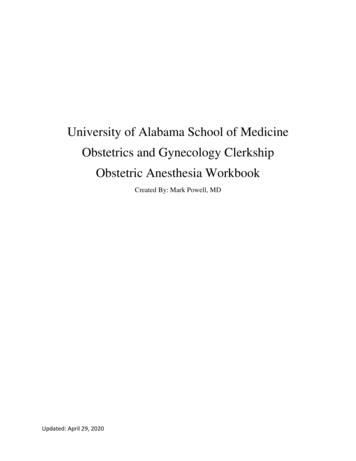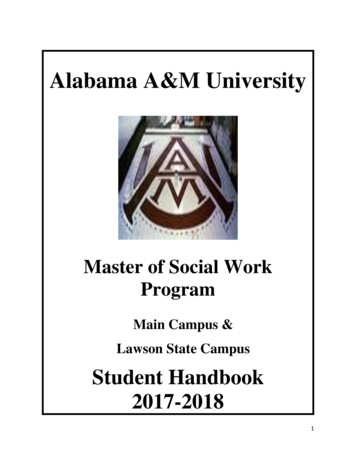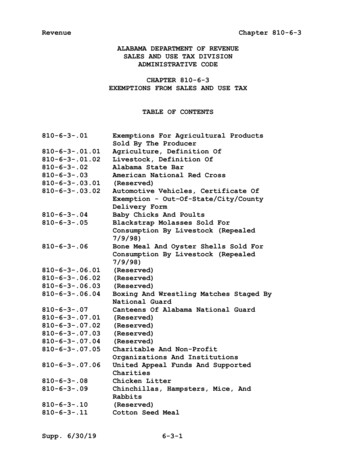
Transcription
University of Alabama School of MedicineObstetrics and Gynecology ClerkshipObstetric Anesthesia WorkbookCreated By: Mark Powell, MDUpdated: April 29, 2020
Table of ContentsRotation Description and Expectations 1Anatomy of Labor Pain . .2Local Anesthetics . .3Types of Neuraxial Blocks . .4Treatment of Labor Pain .5Anesthesia for Surgical Procedures on Labor and Delivery . 6Suggested Reading 7Updated: April 29, 2020
1Rotation Description and ExpectationsObstetric anesthesia is the subspecialty of anesthesia devoted to peripartum, perioperative, painand anesthetic management of women during pregnancy and the puerperium. The subspecialty isrecognized by the ACGME as an accredited fellowship within the specialty of Anesthesiology.For more information on this subspecialty, visit https://soap.org/.During your experience, you will work with OB anesthesia-trained faculty, the OB anesthesiafellow, and residents within the Department of Anesthesiology and Perioperative Medicine atUAB. You will be exposed to patients at all stages of pregnancy and learn the anestheticmanagement of these patients. This will include peripartum planning and optimization of highrisk obstetric patients, labor analgesic techniques, anesthesia for obstetrical surgery, andmanagement of postpartum complications.Expectations from you include:1. Be on time for the start of each day. We have a resident lecture every morning exceptTuesday at 0640 in the anesthesia work area of labor and delivery. We expect you toattend this lecture. You can arrive on Tuesday at 0800.2. Be involved in patient care and ask questions. This will likely be the only time duringyour medical school training you will see pain management strategies for the parturient.Active engagement in their care will increase your ability to retain this information.3. Be respectful of the patients and their families. We serve a diverse patient population,with patients coming from different backgrounds; however, all are experiencing a lifechanging event. This event might be perceived as positive or negative. As a physician, itis important that we help support them through this time.4. Communicate any needs you have with our residents, fellow, or faculty. We are here tohelp with your education. If there is something you need, please let us know.Updated: April 29, 2020
2Anatomy of Labor PainThe type and location of pain can change throughout labor. Each patient will perceive paindifferently and have a different expectation of pain and pain control during labor. As consultants,we will discuss expectations with each patient and determine an anesthetic plan based on theindividual patient’s needs. Typically, we attempt to control pain for two stages of labor: Stage 1and Stage 2. Rarely, do we need to provide pain control after delivery. Each stage of labor isinnervated by different nerve fibers and can require an adjustment in medications to effectivelyrelieve the pain. Below is a table that summarizes these stages.Stage12Cause of PainUterine contraction andcervical dilationVaginal and perineumdistention and injuryDermatome LevelT10 – L1S2 – S4 (Pudendalnerve)Pain TypeVisceral, nonlocalizedSomatic, localizedBelow is a dermatome diagram demonstrating where sensory loss has to occur to control the painassociated with each stage of labor. The major anatomical landmark to assess the upper limit toproduce adequate analgesia (T10 dermatome) is the umbilicus.Updated: April 29, 2020
3Local AnestheticsEffective control of labor pain is accomplished by the use of local anesthetics. Local anestheticswork by inhibiting nerve conduction by blockade of sodium channels on the intracellular portionof the neuronal cell membrane.There are two main classes of local anesthetics. They are amino-esters and amino-amides andare named for the type of bond (ester vs. amide) connecting the aromatic ring and hydrocarbonchain. Esters are metabolized by pseudocholinesterase and examples include procaine,chloroprocaine, tetracaine, and cocaine. Amides are metabolized in the liver and examples arelidocaine, bupivacaine, and ropivacaine. Below is a table highlighting properties of commonlocal anesthetics used on labor and delivery. These properties will affect the local anesthetic’sonset of action (pKa), potency (lipid solubility), and duration of action (protein binding).Local AnestheticpKaRelative Lipid SolubilityRelative Protein BindingMax Dose (mg/kg)Chloroprocaine8.7--12Lidocaine7.8 4.5; 7 (with epinephrine)Bupivacine8.1 3Ropivacaine8.1 3Other medications can be given in combination with the local anesthetics to enhance the block.Common additives include:1. Opioids: Site of action is on the dorsal horn of the spinal cord. Examples includemorphine (water-soluble opioid) and fentanyl (lipid-soluble opioid).2. Sodium bicarbonate: Increases the pH of the surrounding environment to speed up theonset of action.3. Epinephrine: Can increase the duration of action of the local anesthetic (vasoconstrictionand reduced systemic absorption) and quality of the block (α2 agonism).4. Clonidine: Can increase the duration of action and quality of the block (α2 agonism).Updated: April 29, 2020
4Types of Neuraxial BlocksThere are three main types of neuraxial blocks used on labor and delivery. The three techniquesused are: epidural, spinal, and combined spinal-epidural (CSE). These blocks describe where themedication is placed and not the type or reason for the placement of the medication. Each type ofblock has its advantages and disadvantages. The clinical situation will dictate the type of blockperformed. These blocks are described below.1. Epidural: Placement of a catheter or medication into the epidural space. The epiduralspace is a potential space located between the ligamentum flavum (LV) and the duramater. Contents of this space include fat, arteries, veins, lymphatics, and nerves. Thevenous plexus network consists of valveless veins that will distend with increases inintra-abdominal pressure (i.e. contractions). The greatest depth of the epidural space (thedistance from LV to dura mater) is located midline between L2 and L3 and isapproximately 5.0 and 6.0 mm deep.2. Spinal: Placement of a catheter (rare) or medication into the cerebrospinal fluid (CSF).The spinal space will be anterior (or deep) to the dura mater.3. Combined spinal-epidural (CSE): Placement of a catheter or medication into both theCSF and epidural space.Image: Kalil A. Unintended subdural injection: A complication of epidural anesthesia: a case report. AANA JournalNeuraxial TypeEpiduralSpinalCombined Spinal-EpiduralUpdated: April 29, 2020AdvantagesContinuous infusion ofmedication; control of onset;no dural punctureReliable block; rapid onset;small amounts of medicationRapid onset with ability toprovide continuous infusionDisadvantagesRequires large amounts ofmedications (can increase riskof toxicity); slow onsetLimited duration (withoutcatheter); dural punctureInability to immediately testepidural catheter; duralpuncture; risk of toxicity
5Treatment of Labor PainThere are multiple options for the treatment of labor pain. Several of the more common therapiesare described below. Neuraxial block: This is the most common form of labor analgesia with 90% of patientsrequesting this at UAB. This is achieved by placing a catheter in the epidural space eitherby an epidural or CSE block. A continuous infusion of a local anesthetic/opioid mixtureis administered throughout labor and delivery with a goal of anesthetizing nerve fibersfrom T10 – L1 during stage 1 of labor and T10 – S4 during stage 2.Parentral opioids: This option is less effective than neuraxial analgesia. The mostcommonly used opioid at UAB is fentanyl. It is highly potent, has a fast-onset and shortduration of action, and does not have active metabolites. These properties are what makesit one of the most ideal opioids for labor analgesia. Remifentanil is a highly-potent,rapidly metabolized opioid. It can be used to control labor pain, but because of significantside effects (drowsiness, respiratory failure, and chest rigidity), it is routinely not used atUAB. A secondary opioid used at UAB is butorphanol (Stadol), a mixed agonistantagonist. Morphine, meperidine, and hydromorphone are not used for pain control forlabor at UAB.Nitrous oxide: This modality is safe for both the mother and newborn. Patients reporthigh satisfaction with its use; however, it is not effective at providing significant painrelief. The majority of patients who use nitrous oxide for labor will switch to another painmanagement technique prior to delivery. This plus the expense of the equipment and needfor a scavenging system limits its usefulness, and it is not offered at UAB.Paracervical block: Pain relief for stage 1 of labor (nerve fibers T10 – L1). This techniquewill block nerve fibers at the paracervical ganglion (Frankenhauster’s ganglion) – locatedimmediately posterolateral to the cervicouterine junction. 5-10 ml of a low-concentrationlocal anesthetic (without epinephrine) is injected bilaterally. Complications of this blockinclude: vaginal mucosal injury, hematoma, neuropathy, abscess, vasovagal syncope,local anesthetic toxicity, direct injection into the fetal scalp and its consequences, andfetal bradycardia (most common fetal complication).Pudendal nerve block: Pain relief for stage 2 of labor (nerve fibers S2 – S4). The needle ispositioned medially and posterior to the ischial spine. The nerve lies in close proximity tothe pudendal artery, so aspiration must occur before injection. 5-10 ml of a lowconcentration local anesthetic is inject bilaterally. Fetal complications are rare with thisblock. Maternal complications are similar to that of the paracervical block.Updated: April 29, 2020
6Anesthesia for Surgical Procedures on Labor & DeliveryThere are four common procedures performed on the labor and delivery suite. The table belowwill list these procedures and considerations for each.ProcedureCesareanDeliveryBilateral TubalLigationCervical CerclagePlacementDilation &CurretageTypical SurgicalDuration (min)45-120 minutesRequiredSurgical LevelT4-T6Neuraxial Type15-30 minutesT4-T615-30 minutesT10Spinal, epidural, orCSESpinal, epidural, orCSESpinal15-30 minutesT10SpinalThe table listed above accounts for average surgical cases. There are outliers for every case, soanesthetic determinations are determined on a case-by-case basis. Knowledge of the fundamentalproperties of local anesthetics (discussed on page 3) and surgical requirements will help theanesthesiologist determine the appropriate local anesthetic and dose to administer for eachprocedure. As a spinal anesthetic is the most commonly chosen type of neuraxial block for eachprocedure, the anesthesiologist has to administer a local anesthetic that will reach the appropriatesurgical level, provide surgical anesthesia for the duration of the case, and regress at a rate thatwon’t prolong recovery from the block.Updated: April 29, 2020
7Suggested Reading Chestnut DH, Wong CA, Tsen LC, et al. eds. Chestnut’s Obstetric Anesthesia: Principlesand Practice. 6th ed. Philadelphia, PA: Elsevier.o Chapter 12: Spinal, epidural, and caudal anesthesia: anatomy, physiology, andtechniqueo Chapter 13: Local anesthetics and opioidso Chapter 22: Systemic analgesia: parenteral and inhalational agentso Chapter 23: Epidural and spinal analgesia: anesthesia for labor and vaginaldeliveryo Chapter 24: Alternative regional analgesic techniques for labor and vaginaldeliveryUpdated: April 29, 2020
Local Anesthetics Effective control of labor pain is accomplished by the use of local anesthetics. Local anesthetics work by inhibiting nerve conduction by blockade of sodium channels on the intracellular portion of the neuronal cell membrane. There are two main classes of local











